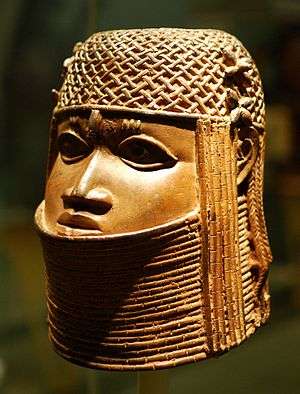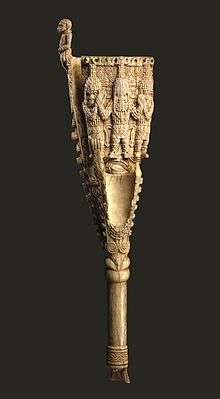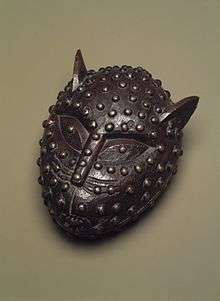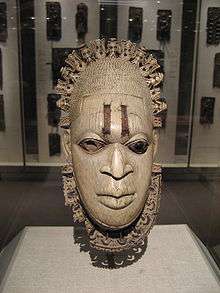Benin art

Benin art is the art from the Kingdom of Benin or Edo Empire (1440–1897), a pre-colonial African state located in what is now known as the South-South region of Nigeria. Primarily made of cast bronze and carved ivory, Benin art was produced mainly for the court of the Oba of Benin - a divine ruler for whom the craftsmen produced a range of ceremonially significant objects. The full complexity of these works can be appreciated only through the awareness and consideration of two complementary cultural perceptions of the art of Benin: the Western appreciation of them primarily as works of art, and their understanding in Benin as historical documents and as mnemonic devices to reconstruct history, or as ritual objects. This original significance is of great import in Benin.[1]
The royal arts of Benin
The royal arts of the Benin Kingdom of south-central Nigeria affirm the centrality of the oba, or divine king, portraying his divine nature. While recording the kingdom’s significant historical events and the oba's involvement with them, they also initiate the oba’s interactions with the supernatural and honor his deified ancestors, forging a continuity that is vital to the kingdom’s well-being.[2]
The materials used in Benin’s royal arts—primarily brass, ivory, and coral—are endowed with sacred power. The innate value of these materials within Benin and the time and skill that is invested in working them reflect the earthly and otherworldly influence of the oba and the great wealth of his kingdom. Benin’s royal arts belong to a tradition that favors convention even as it promotes creativity and innovation, especially as a reflection of royal prerogative. Through time, rulers have used the arts to interpret the history of the kingdom and to orient themselves with the past in an effort to support their own initiatives and define their images for posterity.
Although only made popular to Western audiences after the Punitive Expedition in the 19th century, Benin art has been in existence since at least the 13th century.
Ancestral altars
For the full article on ancestral altars see Benin ancestral altars
A newly installed oba is responsible for creating an altar dedicated to his father, commissioning the appropriate objects to adorn it and activating it on a regular basis with sacrifices of food or animal blood. The oba does the same for his mother if she attained the title of iyoba, or queenmother. While bells and rattle staffs are placed on all ancestral altars, ivory tusks and commemorative brass heads are made specifically for royal altars. Associated with trade, ivory and brass are durable and valuable, and their colors—white like sacred kaolin clay and red like fire and coral beads—relate to royal power.
Before the British conquest, an oba’s courtyard was the focal point for rituals in his honor. British troops reported 18 altars dedicated to previous obas when they took possession of the palace in 1897. Today, all of the royal altars stand together in a single courtyard.[2]
One of the objects unique to Benin art is an Ikegobo, or "altars to the hand," which celebrates the accomplishments of exceptional individuals. The hand is associated with action and productivity, and is considered the source of wealth, status, and success for all those who depend on manual skill and physical strength. Altars of this kind are commissioned in terracotta, wood, or brass, depending on the status of the patron.[3]
Art related to rituals at court
For the full article on art related to rituals at court see Benin court and ceremonial art

Private and public ceremonies mark many of the important moments in Benin’s yearly calendar. In the past, an elaborate series of rites were performed throughout the year to secure otherworldly support for the kingdom’s well-being and to celebrate decisive events in its history. For the sake of convenience, the current monarch, Oba Erediauwa, emphasizes the end-of-year festival called Igue, which is held during the winter holidays to allow the greatest number of people to attend. Igue includes a sequence of rituals that renew the oba’s supernatural powers and cleanse the kingdom’s unruly spirits.
Benin’s other important ritual festivals include Ague, where the first budded yams are blessed in hopes of a successful harvest; Ugie Ivie, the Festival of Beads, in which the oba’s coral and red stone regalia is bathed in cow’s blood to reinvest it with spiritual force; Ugie Erha Oba, which honors the oba’s father and all paternal ancestors; Oduduwa, a masquerade that likewise honors the oba’s paternal ancestors; and Ugie Oro, celebrating Oba Esigie’s victory over the Idah Kingdom in the 16th century.
Finely carved ivory double gongs are examples of art related to rituals at court. They are called “double” gongs because of second, smaller resonating cups at their front. Typically, the central image is the oba in coral regalia supported by the high priests osa and osuan, officials who tend the altars of the kingdom’s two patron gods. These gongs are still carried today by the oba during Emobo, the last of the empowering rites of the Igue festival. The oba gently taps the ivory instrument, creating a rhythmic sound to calm and dismiss unruly spirits from the kingdom.
Leopard imagery in the arts of Benin

The oba is referred to metaphorically as “the leopard of the house,” and images of the beautiful, cunning, and immensely dangerous cat appear frequently in Benin’s royal arts. Before the British invasion in 1897, domesticated leopards were kept in the palace to demonstrate the oba’s mastery over the wilderness. Leopard imagery is also frequently linked to the oba’s military might.
The Oba's regalia
The oba’s divine right to rule is reiterated in his regalia. His coral crowns, shirts, aprons, necklaces, and accessories refer to those that Oba Ewuare is said to have stolen from Olokun, the god of the waters and prosperity. Coral and red stones such as jasper and agate are also filled with supernatural energy, or ase, as are elephant ivory and brass, two other valuable materials that the oba has historically controlled.
Despite his divine status, the oba can not rule alone. He must rely on others to fulfill his destiny, a dependence that is physically expressed when he walks or sits with his arms supported at the elbows and wrists by attendants. They help him bear the weight of his regalia, a constant reminder of the burden of kingship.[2]
Brass Casting
Brass casters (igun eronmwon) are the highest-ranking craft guild within the hierarchical structure of the Iwebo society, followed by blacksmiths (igun ematon) and ivory and wood carvers (igbesanwan).
The origins of brass casting in Benin are debated. One popular story credits Oba Oguola (enthroned c. 1280) with sending for a master brass caster from Ile Ife, the capital city of the ancient Ife Kingdom to the northwest, and with later establishing a royal brass-casting guild.[4][5] Others suggest brass casting developed independently in Benin and may have mutually benefited from exchange with Ile Ife.[6] Casters in both regions used the lost wax method, in which a precisely detailed wax model is formed over a clay core. When the model is complete, clay is carefully applied over the wax. It is then heated, melting the wax, which exits from a narrow channel. Next, molten metal is poured into the mold. Once cool, the hardened clay is chipped away, leaving behind an image now cast in bronze.[1]
The Punitive Expedition
The decline of Benin art occurred in the 19th century when the Punitive expedition by the British caused impairment in the creation of the arts. On February 18, 1897, the British arrived in Benin City under orders to invade and conquer it. As a result, the possessions of the oba and his court became spoils of war. The objects were rounded up with little regard for their associated meaning; no systematic record was kept of their grouping or placement. Many of these objects were sold in London to defray the cost of the expedition.
References
| Part of a series on the |
| Culture of Nigeria |
|---|
 |
| History |
| People |
| Languages |
| Cuisine |
| Religion |
|
Music and performing arts |
| Sport |
|
Monuments |
|
Symbols |
|
- 1 2 Barbara Plankensteiner, ed. (2007). Benin- Kings and Rituals: Court Art from Nigeria. Exhibition catalogue Kunsthistoriches Museum Vienna mit MVK und OTM/Snoeck.
- 1 2 3 "Benin—Kings and Rituals: Court Arts from Nigeria". The Art Institute of Chicago. Retrieved 2 April 2013.
- ↑ "Oba with Animals, Altar to the Hand (Ikegobo) of Ezomo Ehenua [Nigeria; Edo peoples, court of Benin] (1991.17.113,1996.11)". Heilbrunn Timeline of Art History. New York: The Metropolitan Museum of Art. 2000. Retrieved 3 April 2013.
- ↑ Inneh, David (2007). Barbara Plankensteiner, ed. Benin kings and rituals : court arts from Nigeria. Ghent: Snoeck. ISBN 9053496262.
- ↑ Egharevba, Jacob U. (1968). A Short History of Benin, 4th Edition. Ibadan University Press.
- ↑ Gore, Charles (Summer 1997). "Casting Identities in Contemporary Benin". African Arts. 30 (3): 54–61, 93. doi:10.2307/3337500.
External links
| Wikimedia Commons has media related to Art of Benin kingdom. |
- Penn Museum - Benin Collection
- Art and oracle: African art and rituals of divination, an exhibition catalog from The Metropolitan Museum of Art (fully available online as PDF), which contains material on Benin art
- Royal Art of Benin: The Perls Collection, an exhibition catalog from The Metropolitan Museum of Art (fully available online as PDF)
- Antiquities from the city of Benin and from other parts of West Africa in the British Museum, a catalog from The British Museum (fully available online as PDF)
- Art of Oceania, Africa, and the Americas from the Museum of Primitive Art: an exhibition at the Metropolitan Museum of Art, an exhibition catalog from The Metropolitan Museum of Art Libraries (fully available online as PDF)
